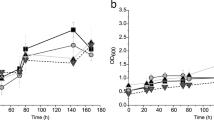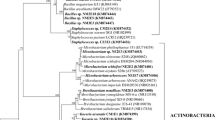Abstract
A collection of 219 bacterial arsenic-resistant isolates was constituted from neutral arsenic mine drainage sediments. Isolates were grown aerobically or anaerobically during 21 days on solid DR2A medium using agar or gelan gum as gelling agent, with 7 mM As(III) or 20 mM As(V) as selective pressure. Interestingly, the sum of the different incubation conditions used (arsenic form, gelling agent, oxygen pressure) results in an overall increase of the isolate diversity. Isolated strains mainly belonged to Proteobacteria (63 %), Actinobacteria (25 %), and Bacteroidetes (10 %). The most representative genera were Pseudomonas (20 %), Acinetobacter (8 %), and Serratia (15 %) among the Proteobacteria; Rhodococcus (13 %) and Microbacterium (5 %) among Actinobacteria; and Flavobacterium (13 %) among the Bacteroidetes. Isolates were screened for the presence of arsenic-related genes (arsB, ACR3(1), ACR3(2), aioA, arsM, and arrA). In this way, 106 ACR3(1)-, 74 arsB-, 22 aioA-, 14 ACR3(2)-, and one arsM-positive PCR products were obtained and sequenced. Analysis of isolate sensitivity toward metalloids (arsenite, arsenate, and antimonite) revealed correlations between taxonomy, sensitivity, and genotype. Antimonite sensitivity correlated with the presence of ACR3(1) mainly present in Bacteroidetes and Actinobacteria, and arsenite or antimonite resistance correlated with arsB gene presence. The presence of either aioA gene or several different arsenite carrier genes did not ensure a high level of arsenic resistance in the tested conditions.



Similar content being viewed by others
References
Achour AR, Bauda P, Billard P (2007) Diversity of arsenite transporter genes from arsenic-resistant soil bacteria. Res Microbiol 158:128–137
Achour-Rokbani A, Cordi A, Poupin P, Bauda P, Billard P (2010) Characterization of the ars gene cluster from extremely arsenic-resistant microbacterium sp. Strain A33. Appl Environ Microbiol 76:948–955. doi:10.1128/AEM. 01738-09
Altschul SF, Gish W, Miller W, Myers EW, Lipman DJ (1990) Basic local alignment search tool. J Mol Biol 215:403–410
Bruneel O, Duran R, Koffi K, Casiot C, Fourçans A, Elbaz-Poulichet F, Personné JC (2006) Microbial diversity in a pyrite-rich tailings impoundment (Carnoules, France). Geomicrobiol J 22:249–257
Cai L, Liu G, Rensing C, Wang G (2009) Genes involved in arsenic transformation and resistance associated with different levels of arsenic-contaminated soils. BMC Microbiol 9:4. doi:10.1186/1471-2180-9-4
Cavalca L, Zanchi R, Corsini A, Colombo M, Romagnoli C, Canzi E, Andreoni V (2010) Arsenic-resistant bacteria associated with roots of the wild Cirsium arvense (L.) plant from an arsenic polluted soil, and screening of potential plant growth-promoting characteristics. Syst Appl Microbiol 33:154–164. doi:10.1016/j.syapm.2010.02.004
Cébron A, Norini MP, Beguiristain T, Leyval C (2008) Real-time PCR quantification of PAH-ring hydroxylating dioxygenase (PAH-RHDα) genes from Gram positive and Gram negative bacteria in soil and sediment samples. J Microbiol Methods 73:148–159. doi:10.1016/j.mimet.2008.01.009
Chang JS, Yoon IH, Kim KW (2007) Isolation and ars detoxification of arsenite-oxidizing bacteria from abandoned arsenic-contaminated mines. J Microbiol Biotechnol 17:812–821
Chang JS, Kim YH, Kim KW (2008) The ars genotype characterization of arsenic-resistant bacteria from arsenic-contaminated gold-silver mines in the Republic of Korea. Appl Microbiol Biotechnol 80:155–165. doi:10.1007/s10653-008-9170-0
Chang JS, Yoon IH, Lee JH, Kim KR, Kim KW (2010) Arsenic detoxification potential of aox genes in arsenite-oxidizing bacteria isolated from natural and constructed wetlands in the Republic of Korea. Environ Geochem Health 32:95–105. doi:10.1007/s10653-009-9268-z
Chang JS, Lee JH, Kim IS (2011) Bacterial aox genotype from arsenic contaminated mine to adjacent coastal sediment: evidences for potential biogeochemical arsenic oxidation. J Hazard Mater 193:233–242. doi:10.1016/j.jhazmat.2011.07.055
Chen CM, Misra TK, Silver S, Rosen BP (1986) Nucleotide sequence of the structural genes for an anion pump. The plasmid-encoded arsenical resistance operon. J Biol Chem 261:15030–15038
Cole JR, Wang Q, Cardenas E, Fish J, Chai B, Farris RJ, Kulam-Syed-Mohideen AS, McGarrell DM, Marsh T, Garrity GM, Tiedje JM (2009) The ribosomal database project: improved alignments and new tools for rRNA analysis. Nucleic Acids Res 37:141–145. doi:10.1093/nar/gkn879
Davolos D, Pietrangeli B (2011) Phylogenetic analysis on the arsenic-resistant bacteria isolated from three different freshwater environments. Chem Ecol 27:79–87. doi:10.1016/j.ecoenv.2013.05.039
Dray S, Dufour AB, Chessel D (2007) The ade4 package-II: two-table and K-table methods. Rep Newsmag 7:47–52
Drewniak L, Styczek A, Majder-Lopatka M, Sklodowska A (2008) Bacteria, hypertolerant to arsenic in the rocks of an ancient gold mine, and their potential role in dissemination of arsenic pollution. Environ Pollut 156:1069–1074. doi:10.1016/j.envpol.2008.04.019
Escalante G, Campos V, Valenzuela C, Yañez J, Zaror C, Mondaca M (2009) Arsenic resistant bacteria isolated from arsenic contaminated river in the Atacama desert (Chile). Bull Environ Contam Toxicol 83:657–661. doi:10.1007/s00128-009-9868-4
Ferguson RL, Buckley EN, Palumbo AV (1984) Response of marine bacterioplankton to differential filtration and confinement. Appl Environ Microbiol 47:49–55
Halter D, Cordi A, Gribaldo S, Gallien S, Goulhen-Chollet F, Heinrich-Salmeron A et al (2011) Taxonomic and functional prokaryote diversity in mildly arsenic-contaminated sediments. Res Microbiol 162:877–887. doi:10.1016/j.resmic.2011.06.001
Hamamura N, Macur RE, Korf S, Ackerman G, Taylor WP, Kozubal M et al (2009) Linking microbial oxidation of arsenic with detection and phylogenetic analysis of arsenite oxidase genes in diverse geothermal environments. Environ Microbiol 11:421–431. doi:10.1111/j.1462-2920.2008.01781.x
Heinrich-Salmeron A, Cordi A, Brochier-Armanet C, Halter D, Pagnout C, Abbaszadeh-fard E et al (2011) Unsuspected diversity of arsenite-oxidizing bacteria revealed by a widespread distribution of the aoxB gene in prokaryotes. Appl Environ Microbiol 77:4685–4692. doi:10.1128/AEM. 02884-10
Honschopp S, Brunken N, Nehrhorn A, Breunig HJ (1996) Isolation and characterization of a new arsenic methylating bacterium from soil. Microbiol Res 151:37–41
Jackson CR, Harrison KG, Dugas SL (2005) Enumeration and characterization of culturable arsenate resistant bacteria in a large estuary. Syst Appl Microbiol 28:727–734
Ji G, Silver S (1992) Regulation and expression of the arsenic resistance operon from Staphylococcus aureus plasmid pI258. J Bacteriol 174:3684–3694
Kulp TR, Hoeft SE, Miller LG, Saltikov CW, Murphy JN, Han S et al (2006) Dissimilatory arsenate and sulfate reduction in sediments of two hypersaline, arsenic-rich soda lakes: Mono and Searles Lakes, California. Appl Environ Microbiol 72:6514–6526
Malasarn D, Saltikov CW, Campbell KM, Santini JM, Hering JG, Newman DK (2004) arrA is a reliable marker for As(V) respiration. Science 306:455
Oremland RS, Stolz JF (2003) The ecology of arsenic. Science 300:939–944
Páez-Espino D, Tamames J, Lorenzo V, Cánovas D (2009) Microbial responses to environmental arsenic. BioMetals 22:117–130. doi:10.1007/s10534-008-9195-y
Pérez-Jiménez JR, DeFraia C, Young LY (2005) Arsenate respiratory reductase gene (arrA) for Desulfosporosinus sp. strain Y5. Biochem Biophys Res Commun 338:825–829
Poirel J, Joulian C, Leyval C, Billard P (2013) Arsenite-induced changes in abundance and expression of arsenite transporter and arsenite oxidase genes of a soil microbial community. Res Microbiol 164:457–465. doi:10.1016/j.resmic.2013.01.012
Qin J, Rosen BP, Zhang Y, Wang G, Franke S, Rensing C (2006) Arsenic detoxification and evolution of trimethylarsine gas by a microbial arsenite S-adenosylmethionine methyltransferase. Proc Natl Acad Sci U S A 103:2075–2080
Quéméneur M, Heinrich-Salmeron A, Muller D, Lièvremont D, Jauzein M, Bertin PN et al (2008) Diversity surveys and evolutionary relationships of aoxB genes in aerobic arsenite-oxidizing bacteria. Appl Environ Microbiol 74:4567–4573. doi:10.1128/AEM. 02851-07
Quéméneur M, Cébron A, Billard P, Battaglia-Brunet F, Garrido F, Leyval C et al (2010) Population structure and abundance of arsenite-oxidizing bacteria along an arsenic pollution gradient in waters of the upper Isle river basin France. Appl Environ Microbiol 76:4566–4570. doi:10.1128/AEM. 03104-09
R Development Core Team (2011) R: a language and environment for statistical computing. R Foundation for Statistical Computing, Vienna, Austria. ISBN 3-900051-07-0, URL http://www.R-project.org/
Rhine ED, Onesios KM, Serfes ME, Reinfelder JR, Young LY (2008) Arsenic transformation and mobilization from minerals by the arsenite oxidizing strain WAO. Environ Sci Technol 42:1423–1429
Rozen S, Skaletsky H (2000) Primer3 on the WWW for general users and for biologist programmers. In: Misener S, Krawetz SA (eds) Bioinformatics methods and protocols, vol 132. Humana Press, Totowa, pp 365–386
Shariatpanahi M, Anderson AC, Abdelghani AA, Englande AJ, Hughes J, Wilkinson RF (1981) Biotransformation of the pesticide sodium arsenate. J Environ Sci Health B 16:35–47
Sharma VK, Sohn M (2009) Aquatic toxicity, speciation, transformations, and remediation. Environ Int 35:743–759. doi:10.1016/j.envint.2009.01.005
Silver S, Phung LT (2005) Genes and enzymes involved in bacterial oxidation and reduction of inorganic arsenic. Appl Environ Microbiol 71:599–608
Spuches AM, Kruszyna HG, Rich AM, Wilcox DE (2005) Thermodynamics of the As(III)-thiol interaction : arsenite and monomethylarsenite complexes with glutathione, dihydrolipoic acid and other thiol ligands. Inorg Chem 44:2964–2972
Sri Lakshmi Sunita M, Prashant S, Bramha Chari PV, Nageswara Rao S, Balaravi P, Kavi Kishor PB (2012) Molecular identification of arsenic-resistant estuarine bacteria and characterization of their ars genotype. Ecotoxicology 21:202–212. doi:10.1007/s10646-011-0779-x
Stahl DA, Amann RI (1991) Development and application of nucleic acid probes. In: Stackebrandt E, Goodfellow M (eds) Nucleic Acid Techniques in Bacterial Systematics. John Wiley & Sons, Chichester, UK, pp 205–248
Sultana M, Vogler S, Zargar K, Schmidt AC, Saltikov C, Seifert J, Schlömann M (2012) New clusters of arsenite oxidase and unusual bacterial groups in enrichments from arsenic contaminated soil. Arch Microbiol 194:623–635. doi:10.1007/s00203-011-0777-7
Tamaki H, Sekiguchi Y, Hanada S, Nakamura K, Nomura N, Matsumura M et al (2005) Comparative analysis of bacterial diversity in freshwater sediment of a shallow eutrophic lake by molecular and improved cultivation-based techniques. Appl Environ Microbiol 71:2162–2169
Valverde A, Gonzales-Tirante M, Medina-Sierra M, Santa-Regina I, Garcia Sanchez A, Igual JM (2011) Diversity and community structure of culturable arsenic resistant bacteria across a soil arsenic gradient at an abandoned tungsten-tin mining area. Chemosphere 85:129–134. doi:10.1016/j.chemosphere.2011.06.025
Wang L, Chen S, Xiao X, Huang X, You D, Zhou X, Deng Z (2006) arsRBOCT arsenic resistance system encoded by linear plasmid pHZ227 in Streptomyces sp. strain FR-008. Appl Environ Microbiol 72:3738–3742
Zargar K, Hoeft S, Oremland R, Saltikov CW (2010) Identification of a novel arsenite oxidase gene arxA in the haloalkaliphilic arsenite oxidizing bacterium Alkalilimnicola ehrlichii strain MLHE-1. J Bacteriol 192:3755–3762. doi:10.1128/JB.00244-10
Acknowledgments
Audrey Cordi was supported by grants from the French Ministry of Research. This study was financed by the EC2CO program (Institut National des Sciences de l’Univers, CNRS). Authors thank the International Science Editing for rendering English editing services on this paper.
Author information
Authors and Affiliations
Corresponding author
Additional information
Responsible editor: Philippe Garrigues
Electronic supplementary material
Below is the link to the electronic supplementary material.
ESM 1
(DOCX 121 kb)
Rights and permissions
About this article
Cite this article
Cordi, A., Pagnout, C., Devin, S. et al. Determination of physiological, taxonomic, and molecular characteristics of a cultivable arsenic-resistant bacterial community. Environ Sci Pollut Res 22, 13753–13763 (2015). https://doi.org/10.1007/s11356-014-3840-5
Received:
Accepted:
Published:
Issue Date:
DOI: https://doi.org/10.1007/s11356-014-3840-5




